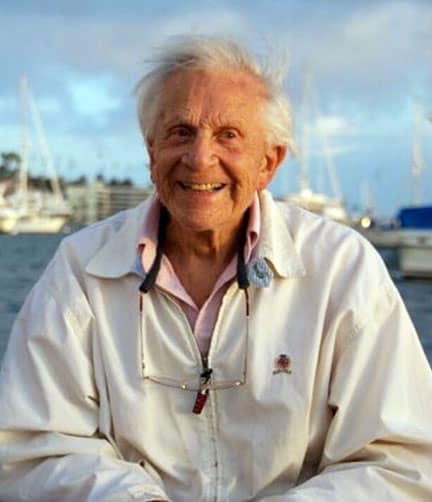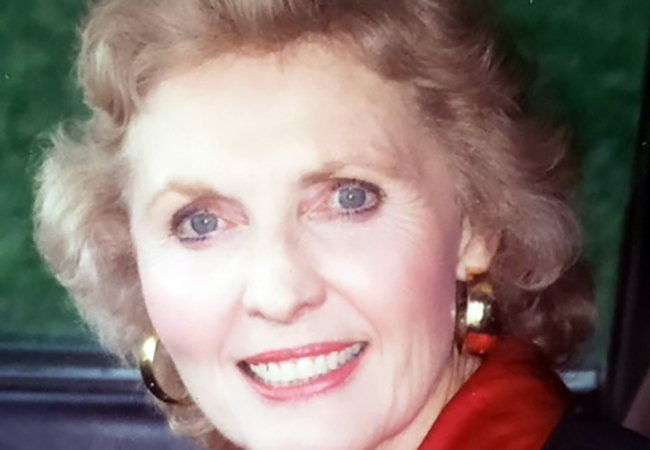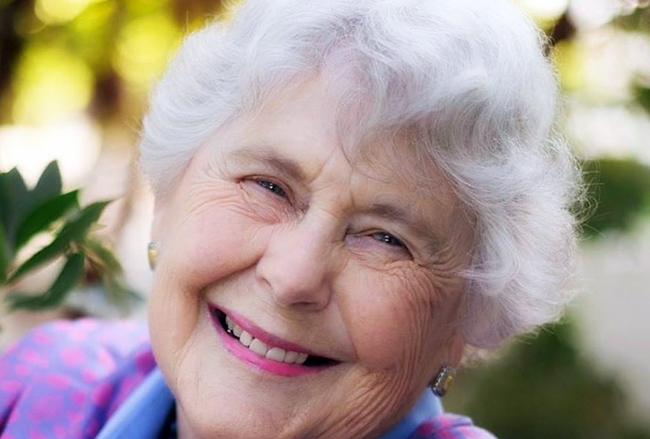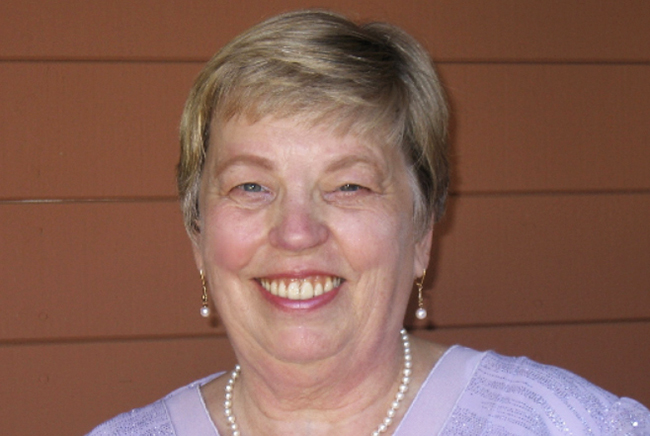Obituary: Paul Darrow

Professor, collage artist, painter, COURIER cartoonist
Artist and professor Paul Darrow died November 11 at his Laguna Beach home. He was 98.
Born October 31, 1921 in Pasadena, California to Frank and Ruth Darrow, his artistic talent shone through at an early age. By the time he was two, he scribbled rainbow colors from his box of Crayola crayons onto butcher paper, which was patiently unfurled by his mother onto the floor of their home.
“We had this roll of brown wrapping paper and she would quietly roll it up on one end as I continued to draw,” he shared with the COURIER in 2002.
Mr. Darrow’s father was an artist and writer, among many other occupations. According to the family, he left when Paul was nine years old, never to return. Frank Darrow died while Paul was in the Army during WWII.

By 16 years old, Mr. Darrow celebrated his first published cartoon—he was paid $2 for a drawing printed in Downbeat Magazine, a publication dedicated to jazz music. Even at this young age, his integrity was apparent:
“A friend of mine gave me the idea so I had to give him a dollar,” Mr. Darrow said.
Art was therapy in the Darrow home. His mother was a practicing Christian Scientist and artist—she would knit and petit point to relieve stress. For her son, pen and paper provided a welcomed diversion from teen angst and a treasured sense of contentment, which he nurtured throughout his life. As he put it, “Art helps get me through the rough spots.”
After attending Pasadena City College, Mr. Darrow joined the Army Air Corps at 21 years old—where he unknowingly witnessed the first atomic bomb explosion in Los Alamos, New Mexico. He landed back in Claremont with his wife Nadine Gunderson, a Pasadena artist and 1942 Rose Parade princess, who before the war, was recruited to study art at Scripps College by Millard Sheets.
After WWII, Paul also wanted to study art with Millard Sheets at the Claremont Graduate School, but had no degree.
On Nadine’s recommendation, Mr. Sheets took on Mr. Darrow (he reportedly said, “Any man that you would marry has got to be good. He’s in!”) and the two forged what would be a lifelong friendship, arguably helping lay the foundation for Claremont’s future art legacy.
Life in Claremont was productive for the young couple—Mr. Darrow worked on his master’s degree on the GI Bill as they were busy raising their expanding family, which resulted in four children—Chris, Joan, Elizabeth and Eric.
Like their parents, the Darrow children all became artists—Chris, a musician and photographer; Joan a photographer, printmaker and painter; Elizabeth, a singer/songwriter and mixed media artist like her father; and Eric, a ceramist.
In 1991, the Darrow family had its first joint show called “5D” in Claremont as part of the Fringe of the Fringe Arts Festival, which according to the Los Angeles Times, had 40 pieces, including woodcuts, prints, paintings, photographs, drawings and sculptures.
After completing his graduate studies, Mr. Darrow was invited by Sheets to join the Scripps faculty, where he taught mixed media, printmaking and advanced drawing for more than 30 years. He was later selected by Mr. Sheets to serve as chair of the art department upon his retirement.
Artist and colleague Roland Reiss shared a tribute to Mr. Darrow online.
“He was an outstanding teacher at Scripps College as well as for many CGU students,” he wrote. “He was also a great artist. He brought a light sense of humor to all of us in everything he did. And for that he will be especially missed. It was always fun to spend time with Paul and his wisdom absorbed in the process. Bon voyage, my friend.”
No matter what campus, when he set up a classroom, Mr. Darrow would hang a copy of his favorite quote by artist Ad Reinhardt, “Art is art and everything else is everything else.” Mr. Darrow was known as a friendly teacher and made close relationships with his students that lasted years after graduating; his children frequently attended his classes at Scripps while growing up and as adults.
Paul and Nadine divorced in the early 1960s, and Mr. Darrow moved to Laguna Beach. He remarried soon after to Sue Smith.
His art and education continued in Laguna when, in 1964, he was commissioned by the Navy Art Liaison Cooperative to draw and paint the scenery while aboard a WWII naval ship in Vietnam, as reported by Laguna Beach Magazine.
His art training was both formal and informal—Mr. Darrow studied with California master painters like Mr. Sheets, Milford Zornes, Phil Dike, Sueo Serisawa and Phil Paradise, while undertaking more traditional coursework at the Colorado Springs Art Center and Claremont Graduate School.
He generously shared his talent as an educator. In addition to his long career at Scripps, he taught classes at Brigham Young University, the Otis Art Institute, the California Institute of Technology in Pasadena and the Laguna Beach School of Art, as well as several summer workshops at Coronado School of Fine Arts. He was also one of the founders of the Los Angeles Printmaking Society.
Mr. Darrow’s state and national accolades are numerous, including lifetime achievement awards from the Claremont Museum of Art and the Laguna Beach Alliance for the Arts; a resident grant from the Ford Foundation and a National Endowment Humanities grant; first in the Los Angeles County Museum exhibition; and first in the Pasadena Museum of Art exhibition, among many other honors.
Throughout his life, Mr. Darrow tried his hand at all forms of art—drawing, painting, collage, ceramics and writing. “That can either mean I am good at a lot of things or I am really bad at a lot of things,” he once quipped.
But he was perhaps best known by many in Claremont for his clever cartoons published in the COURIER. Fresh out of college, publisher Martin Weinberger came from Bakersfield after purchasing the paper in 1954.
“We hit it off right off the bat,” Mr. Darrow said. “We were very compatible politically and we had a lot of fun together. Whenever I got some negative feedback on my stuff, Martin would say, ‘That’s good. It means people are reading it.’”
His weekly cartoons were a defining feature of the twice-weekly newspaper (now weekly) as Mr. Darrow’s talking animals, fish, birds and creatures brought warmth and humor to the local paper for almost 65 years—or as Mr. Darrow once described, “being part of our paper’s life, philosophy and voice.”
“I get lots of fun and semi-serious humor from animals talking about human events” he told the COURIER in 2005. “For example, two short-lived fruit flies wondering about their retirement benefits.”
“There was a little bit of humor in it,” he continued, “but I had to fight that because people would talk about Darrow trying to be cute and that was the worst thing you could say about someone who was serious about art—being cute.”
For Mr. Darrow, nothing was trash. When his Laguna Beach studio was flooded by a prolonged leak from a bathtub, the pieces of damaged artwork and paper were transformed into a series of collages.
“I lugged the box outside and it was a terrible mess,” Mr. Darrow told the COURIER. “And then, as a collagist, some of the things began to look pretty good.”
The work led to a handful of exhibitions at the Peter Blake Gallery in Laguna Beach, where his home studio became a quiet refuge. Laguna gave him a tranquil space to make art but also kept him near the ocean and engrossed in what was perhaps his second great love—sailing.
He was an honored member of the Balboa Yacht Club, where he moored The Gleam, his Cal 30 sailboat. He was a devoted sailor, even racing to Ensenada and taking much-loved sojourns to White’s Landing in Catalina with family and friends.
Outside of art and sailing, Mr. Darrow loved jazz music (he was a jazz clarinetist and saxophonist), regularly practiced yoga, was a Tibetin Buddhist and, of course, was a huge fan of baseball, especially the Dodgers.
But throughout all his endeavors, Mr. Darrow was always creating, whether it be cartoons for publication or quick sketches in a notebook.
“Sketchbooks are possibly the most personal tool in an artist’s itinerary,” Mr. Darrow once shared. “The first ideas—fleeting thoughts, records of people, things and shapes—show up almost unselfconsciously. Like diaries, sketchbooks most often show the real, unadorned creative interests and quest of their owner. Seeing what artists put up on their studio walls is also a peek into their world.”
Mr. Darrow is survived his children Chris Darrow; Joan Darrow Lindley and her husband, David Lindley; Elizabeth Darrow Jones; and Eric Darrow and his wife Rochelle Darrow, all of Claremont.
He is also survived by his grandchildren Steven Darrow (Karin), Roseanne Lindley, Eric Cartwright (Krissy), Mahlea Jones-Bergmann (Bryan), Lauren Jones (Silas) and Bryce Darrow; and great-grandchildren Brennen, Vivienne, Desmond and Ciel.
In lieu of flowers, the family asks locals to honor Mr. Darrow’s memory by purchasing a subscription for someone to the Claremont COURIER at claremont-courier.com.









0 Comments